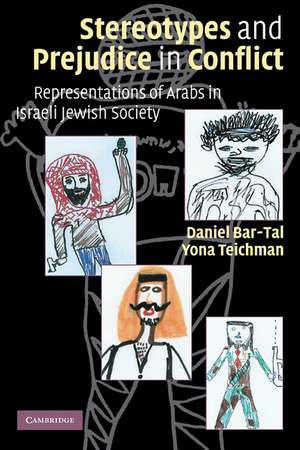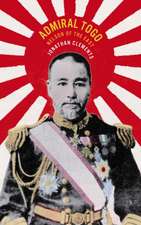Stereotypes and Prejudice in Conflict: Representations of Arabs in Israeli Jewish Society
Autor Daniel Bar-Tal, Yona Teichmanen Limba Engleză Paperback – 2 dec 2009
Preț: 425.03 lei
Nou
Puncte Express: 638
Preț estimativ în valută:
81.33€ • 85.13$ • 67.69£
81.33€ • 85.13$ • 67.69£
Carte tipărită la comandă
Livrare economică 31 martie-14 aprilie
Preluare comenzi: 021 569.72.76
Specificații
ISBN-13: 9780521127035
ISBN-10: 0521127033
Pagini: 504
Dimensiuni: 152 x 229 x 29 mm
Greutate: 0.73 kg
Editura: Cambridge University Press
Colecția Cambridge University Press
Locul publicării:New York, United States
ISBN-10: 0521127033
Pagini: 504
Dimensiuni: 152 x 229 x 29 mm
Greutate: 0.73 kg
Editura: Cambridge University Press
Colecția Cambridge University Press
Locul publicării:New York, United States
Cuprins
Preface; Introduction; General overview; 1. The psychological basis of intergroup relations; 1.1 Intergroup behaviour; 1.2 Psychological intergroup repertoire; 1.3 Formation of the psychological intergroup repertoire; 1.4 Conclusions; 2. Psychological intergroup repertoire in intractable conflicts; 2.1 Intractable conflicts; 2.2 Societal beliefs in intractable conflicts; 2.3 Negative psychological intergroup repertoire; 2.4 Conclusions; 3. The context: The Arab-Israeli intractable conflict; 3.1 Socio-cultural context; 3.2 The intractable nature of the Arab-Israeli conflict; 3.3 The Jewish narrative of the Arab-Israeli conflict; 3.4 Israeli Jewish ethos of conflict; 3.5 Conclusions; 4. Representation of Arabs in public discourse; 4.1 The impact of mass media; 4.2 Public discourse before the establishment of the State; 4.3 Public discourse by leaders; 4.4 Public discourse through the media in the State of Israel; 4.5 Research on the presentation of Palestinians in the Israeli mass media; 4.6 Research on the presentation of Arab citizens of the State of Israel in the media; 4.7 Conclusions; 5. Representation of Arabs in school textbooks; 5.1 Presentation of Arabs in school textbooks of the pre-state period; 5.2 Presentation of Arabs in school textbooks from 1948 up to the early 1970s; 5.3 Presentation of Arabs in school textbooks between the mid 1970s and 1990s; 5.4 Conclusions; 6. Representation of Arabs in cultural products; 6.1 Adult Hebrew literature; 6.2 Children's literature; 6.3 Hebrew drama; 6.4 Israeli films; 6.5 Conclusions; 7. Representation of Arabs by Israeli Jews: review of empirical research; 7.1 Psychological repertoire towards Arabs; 7.2 Views about Arab-Israeli relations; 7.3 Views about Arabs; 7.4 Citizens of Israel; 7.5 Conclusions; 8. The development of shared psychological intergroup repertoire in a conflict: theory and methods; 8.1 The cognitive foundations of social representations; 8.2 Personality development, personality states, and social representations; 8.3 The context of social representations; 8.4 An integrative developmental-contextual approach for the acquisition and development of stereotypes and prejudice; 8.5 Assessment of children's social representations - general considerations; 8.6 Conclusions; 9. Studies with preschoolers; 9.1 Objectives and overview; 9.2 Words, concepts, identities, stereotypes, and attitudes; 9.3 Images, stereotypes, and attitudes in different social environments; 9.4 General discussion; 9.5 Conclusions; 10. Studies with school children, adolescents, and young adults; 10.1 Objectives and overview; 10.2 Image acquisition; 10.3 Influences of specific environments; 10.4 Differentiation and generalisation; 10.5 Sense of knowledge, perceived similarity, and perceived quality of relations as predictors of stereotypes and attitudes; 10.6 General discussion; 10.7 Conclusions; 11. The reflection of social images in human figure drawing; 11.1 The development and meaning of drawings; 11.2 Obtaining and scoring the drawings; 11.3 Scoring the beliefs and intentions questionnaire; 11.4 Research overview and objectives; 11.5 General discussion; 11.6 Conclusions; 12. General conclusions and implications; 12.1 Conclusions; 12.2 Changing the shared psychological intergroup repertoire of people involved in intractable conflict: general observations; 12.3 Changing the psychological intergroup repertoire in the context of intractable conflict: thoughts about intervention; 12.4 Final words; 12.5 References.
Recenzii
Review of the hardback: 'All educators, all politicians - in fact, everyone - should read this book.' Haaretz
Review of the hardback: 'This book is the work of a lifetime. It clarifies prejudice. It can advance the peace process in the Middle East. It is of excellent scientific quality. It is socially highly relevant. It is in the heart of political psychology. It significantly contributes to what Alexander George wanted to say.' Alexander George Book Award Committee
Review of the hardback: '… this impressive book contains several volumes in one. … The depth and nuance of the analysis makes it valuable to all with an interest in Israeli-Jewish-Arab relations.' Journal of Peace Research
Review of the hardback: 'This book is the work of a lifetime. It clarifies prejudice. It can advance the peace process in the Middle East. It is of excellent scientific quality. It is socially highly relevant. It is in the heart of political psychology. It significantly contributes to what Alexander George wanted to say.' Alexander George Book Award Committee
Review of the hardback: '… this impressive book contains several volumes in one. … The depth and nuance of the analysis makes it valuable to all with an interest in Israeli-Jewish-Arab relations.' Journal of Peace Research
Descriere
Presents integrative conceptual frameworks used to analyse the representation of Arabs in Israeli Jewish Society.















